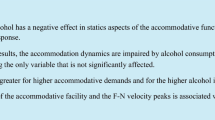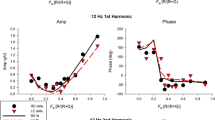Abstract
Color vision tests and electrooculography (EOG) were performed in 6 male and 2 female healthy young trichromatic volunteers between 60 and 130 min after finishing consumption of ethyl alcohol leading to blood levels of approximately 0.07% to 0.16%. The average number of errors in the desaturated Panel D-15 arrangement test rose from 0.86 to 2.0; the average error score in the Farnsworth-Munsell 100-Hue test rose from 26 to 79. The axis of errors in both tests was clearly tritanopic and tetartanopic, pointing to a specific effect of ethyl alcohol on the function of blue-sensitive cones and/or their interaction with longer wavelength-sensitive cones.
Ethyl alcohol decreased the size of the light-peak, apparently in a dose-dependent fashion, in each of the 16 eyes by values between 3% and 79%. The effect of alcohol on the EOG light peak was stronger between 30 and 95 min (23% decrease in average) than between 95 and 130 min (14% decrease) after the finish of alcohol administration.
Similar content being viewed by others
References
Dodt E and Baier M (1984) Area-luminance relationship for a constant light peak of the standing potential in the human eye. Ophthalmologica 188:232–238
Gilg, T, Liebhardt E, Schuller E and Riedel K (1984) Alkoholbedingte Wahrnehmungs-störungen im peripheren Gesichtsfeld. Blutalkohol 21:235–249
Gramberg-Danielsen B (1965) Farbenuntüchtigkeit und Straßenverkehr, Z Verk-Med 11:1–12
Kitahara K (1984) An analysis of the Farnsworth-Munsell 100-Hue test. In: Color Vision Deficiences VII, (ed) Verriest G. Hague, Boston: Dr W Junk, Publishers 247:251
Knave B, Persson HE and Nilsson SEG (1974): A comparative study on the effects of barbiturate and ethyl alcohol on retinal function with special reference to the c-wave of the electroretinogram and standing potential of the sheep eye. Acta Ophthalmol (Kbh) 52:254–259
Koen AI and Shaw CR (1966) Retinol and alcohol dehydrogenases in retina and liver. Biochim Biophys Acta 128:48–54
Köllner H (1912) Die Störungen des Farbensinns. Karger, Berlin
Peters HB (1942) Changes in color fields occasioned by experimentally induced intoxication. J Appl Psychol 26:692–701
Pokorny J, Smith V, Verriest B and Pinckers AJLG (eds) (1979) Congenital and Acquired Color Vision Defects. New York: Grune and Stratton
Remky H (1956) Augenärztliche Befunde bei akuter Alkoholeinwirkung. In: Der Verkehrsunfall, eds: Laves W, Bitzel F and Berger E, pp 221
Riedel KG, Gilg T and Liebhardt E (1985) Wahrnehmungsstörungen im peripheren Gesichtsfeld unter Alkoholeinflu ß. Klin Monatsbl Augenheilk 186:279–283
Russell RM, Carney EA, Felock K, Garret M and Karwoski P (1980) Acute ethanol administration causes transient impairment of blue-yellow color vision. Alcoholism Clin Exp Res 4:396–399
Sakuma Y (1973) Studies on color vision abnormalities in subjects with alcoholism. Ann Ophthalmol 5:1277–1292
Sassoon HF, Wise JB and Watson JI (1970) Alcoholism and color vision: Are there familiar links? Lancet 2:367–368
Skoog K-O (1974) The c-wave of the human dc registered ERG. III. Effects of ethyl alcohol on the c-wave. Acta Ophthalmol 52:913–923
Skoog K-O, Textorius O and Nilsson SEG (1975) Effects of ethyl alcohol on the directly recorded standing potentials of the human eye. Acta Ophthalmol 53:710–720
Skoog K-O, Welinder W and Nilsson SEG (1978) The influence of ethyl alcohol on slow off-responses in the human dc registered electroretinogram. Vision Res 18:1041–1044
Steinberg RH, Linsenmeier RA and Griff ER (1985) Retinal pigment epithelial cell contributions to the electroretinogram and electrooculogram. Progr Retinal Res 4:33–66
Wald G and Hubbard R (1949) The reduction of retinene 1 to Vitamin A1 in vitro. J Gen Physiol 32:367–389
Wallgren H and Barry H (1970) Actions of Alcohol, Vol 1. Amsterdam, London, Elsevier Publishing Company. pp 289–292
Zrenner E (1982) Electrophysiological characteristics of the blue-sensitive mechanism: Test of a model of cone interaction under physiological and pathological conditions. Doc Ophthalmol Proc Series 33:103–125
Zrenner E (1983) Neurophysiological aspects of color vision in primates. Studies of Brain Function Series, Vol 9. Berlin, New York: Springer
Zrenner E, Kramer W, Bittner Ch, Bopp M and Schlepper M (1982) Rapid effects on color vision, following intravenous injections of a new, non-glycoside-positive inotropic substance (AR-L 115 BS) Doc Ophthalmol Proc Series 33:507–521
Zrenner E, Nowicki J and Adamczyk R (1986) Cone function and cone interaction in hereditary degenerations of the central retina. Docum Ophthalmol 62:5–12
Author information
Authors and Affiliations
Rights and permissions
About this article
Cite this article
Zrenner, E., Riedel, K.G., Adamczyk, R. et al. Effects of ethyl alcohol on the electrooculogram and color vision. Doc Ophthalmol 63, 305–312 (1986). https://doi.org/10.1007/BF00220220
Issue Date:
DOI: https://doi.org/10.1007/BF00220220




